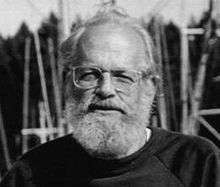Jim Bohlen
Jim Bohlen (July 4, 1926 – July 5, 2010) was an American engineer who worked on the Atlas ICBM missile program and later emigrated to Canada after becoming disillusioned with the US government's nuclear policy during the Cold War. He became one of the founders of Greenpeace.[1]

Bohlen, one of the approximately half-dozen founders of Greenpeace, arguably made the most lasting impression with his brilliant backroom dealings. He effectively out-manoeuvered more high-profile members of the group such as Paul Watson within the organization's inner workings and can be primarily credited with transforming the organization from a small, vociferous Canadian pressure group into the highly efficient international movement it is today. Bohlen was a strong supporter of the creation of Greenpeace International and the move of the group's headquarters from Vancouver to New York City, essentially giving birth to Greenpeace as we know it today. He was also instrumental in developing the group's hierarchical military-style command structure.
He made a similar and even less-acknowledged contribution to Green politics in Canada by negotiating a deal that ended the party's 10-year prohibition against Green Parties having leaders at a meeting of the Green Party of BC in 1992. (Between 1982 and 1992, some Green Parties were required by law to have registered leaders but party constitutions prohibited these individuals from speaking for these parties.) Within four years of Bohlen's breakthrough agreement, all Canadian Green parties had moved to adopt conventional political structures in which their leaders functioned as primary spokespeople.
Bohlen ran for the Greens federally in 1988. Some credit friction between him and long-time enemy Paul Watson for Watson's defection to the NDP during that campaign.
Bibliography
- Jim Bohlen, (2000). Making Waves: The Origin and Future of Greenpeace, Black Rose Books. ISBN 1-55164-166-6
- James Bohlen, (1975). "New Pioneer's Handbook: Getting Back to the Land in an Energy-Scarce World". Schocken. ISBN 0-8052-3591-4
External links
- "Jim Bohlen 1926 – 2010," Greenpeace International, Tuesday, July 6, 2010.
- Grimes, William. "Jim Bohlen, Led in Creation of Greenpeace, Dies at 84," The New York Times, Thursday, July 8, 2010.
- Mackie, John. "Greenpeace pioneer Jim Bohlen dead at 84," The Vancouver Sun, Friday, July 9, 2010.